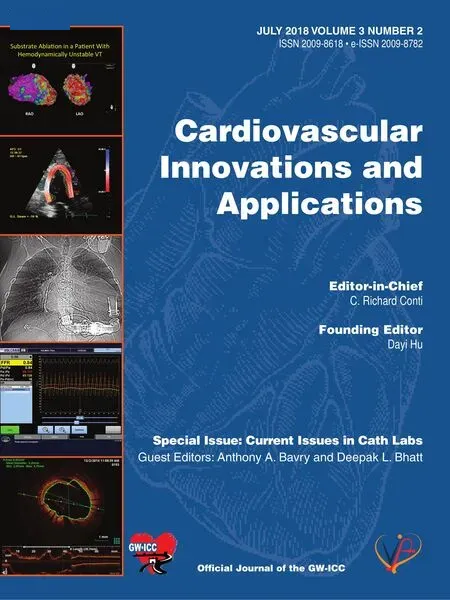Anomalous Coronary Arteries: Some thoughts about Clinical Relevance
C. Richard Conti, MD, MACC
Introduction
Anomalous coronary arteries are found in 0.1%–1.3% of patients undergoing coronary angiography.Anomalous coronary arteries are a rare but important cause of CP, arrhythmia, MI & sudden cardiac death;and are treatable. Angiographic evaluation can be challenging; misdiagnosis can occur in up to 50% of cases. Sometimes these anomalies are missed because of the inexperience of the operator. Anomalous Coronary Arteries can be associated with congenital heart disease or can be an isolated anomaly.
Benign Coronary Artery Anomalies
In general, the following are considered benign in terms of the development of major adverse coronary cardiac events: 1. Separate origin of the left anterior descending and circumflex from the left sinus of Valsalva, 2. Ectopic origin of the circumflex from the right sinus of Valsalva, 3. Ectopic coronary origin from the posterior sinus of Valsalva,4. Anomalous coronary origin from the ascending aorta, 5. Absent circumflex, 6. Intracoronary communications, 7. Small coronary artery fistula.
Potentially serious coronary artery anomalies
1. Ectopic coronary origin from the pulmonary artery;
2. Ectopic coronary origin from the opposite aortic sinus;
3. Single coronary artery;
4. Large coronary fistulae.
As a general rule, I think any artery that takes origin from either sinus of Valsalva and passes between the RV outflow area and the aorta or takes an intramural course through the aorta may put the patient at risk for a future cardiac problem.
Decision-Making for Therapy in Asymptomatic Patients with Congenital Coronary Anomalies
In adults there should be some correlation with functional significance before any revascularization procedure is attempted in the asymptomatic patient. The most common congenital anomaly seen in adult patients is an anomalous circumflex coronary artery which comes from either the right sinus of Valsalva as a separate orifice or off a branch of the right coronary artery. This vessel is almost always retro- cardiac and therefore probably benign. This is easily determined with Computerized Tomographic coronary angiography.Retro-aortic and anterior courses of anomalous coronaries are probably benign.
Coronary Anomalies Found in Adults
Most of the time, the coronary anomalies found in adults are incidental findings and rarely have anything to do with symptoms or prognostication. In the Cleveland clinic series, 81% were “benign”anomalies [1].
Role of Noninvasive Imaging?
It is often challenging to diagnose position of the coronary anomaly during catheter based coronary angiography (e.g. difficult to determine relationship to great vessels).
CT angiography allows evaluation of not just arterial caliber and lumen but also their course and relationship to adjacent structures as well as the takeoff angle of the anomalous vessel from the sinus of Valsalva, thus providing prognostic information.
Cardiac MRI/A is not as useful since current practice eliminates performance on some pts with cardiac pacemakers and ICDs.
Conclusion
Anomalous coronary arteries are rare but potentially life-threatening & treatable causes for CP, MI &sudden cardiac death. Expert catheter-based coronary angiographers can easily identify the anomaly,but may not be able to define the artery’s course precisely. CT angiography can best define the course of the artery and thus play a vital role in decision making about therapy.
Patients who have symptoms of ischemia or arrhythmia due to any type of coronary anomaly should undergo surgical repair. In the asymptomatic patient the decision to have the patient undergo surgery is related to judgment, evidence,experience, and opinion-based consensus. Most decisions are based on experience and opinionbased consensus since there are no hard data or clinical guidelines with level of evidence A in this population. An anomalous coronary artery from the opposite coronary sinus may have clinical relevance and can be either a LCA from the Right or an RCA from the Left Sinus of Valsalva.
Patients who have symptoms of ischemia or arrhythmia with either form of the anomaly should undergo surgical repair.
It is reasonable to conclude, on a risk-benefit basis, that a patient with an anomalous RCA who is asymptomatic with no evidence of ischemia or arrhythmias during stress exercise studies need not undergo elective surgery [2].
 Cardiovascular Innovations and Applications2018年3期
Cardiovascular Innovations and Applications2018年3期
- Cardiovascular Innovations and Applications的其它文章
- Cardiovascular Innovations and Applications
- The Contemporary Role of Femoral Artery Access
- Persisting Angina after Successful Surgical Removal of a Large Coronary Artery Aneurysm Attached to the Proximal Portion of the Left Circumflex Artery: Role of Coronary Artery Spasm
- Speckle Tracking Echocardiography ldentifies lmpaired Longitudinal Strain as a Common Deficit in Various Cardiac Diseases
- Bioresorbable Vascular Scaffold in the Midportion of the Left Anterior Descending Artery for Cardiac Allograft Vasculopathy in a Cardiac Transplant Patient
- The Use of Direct Oral Anticoagulants for Prevention of Stroke and Systemic Embolic Events in East Asian Patients with Nonvalvular Atrial Fibrillation
